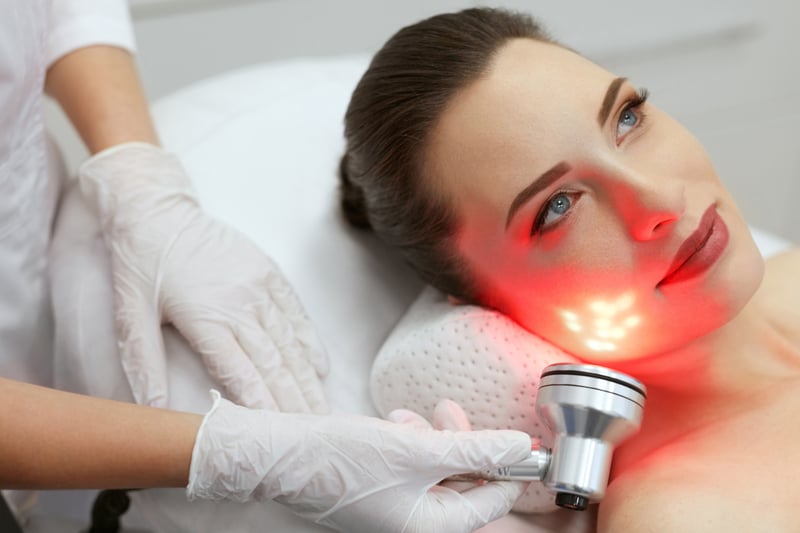Red Light Therapy for Skin: Benefits & Downsides

Most of us are all too familiar with before and after photos of skin showing results that often look too good to be true. And one treatment those types of images are used for is red light therapy. Red light therapy for skin has been emerging as THE treatment to decrease the appearance of wrinkles, redness, and other signs of aging. But it’s also been claimed to reduce the appearance of unsightly acne and scars. So, what is red light therapy, and does it really improve the look of skin?
Red Light Therapy for Skin: What Is It?
Red light therapy is also called RLT, low-level laser light therapy, low-power laser therapy, non-thermal LED light, soft-laser therapy, cold-laser therapy, bio-stimulation, photonic stimulation, phyto-biomodulation, and phototherapy.
Whatever it’s called, the process uses natural, low wavelength light to improve the skin’s health and appearance. It’s potential healing properties appear to be due to its unique LED (light-emitting diode) that emits infrared light.
According to proponents, it’s not only beneficial for skin but for other medical conditions as well. In addition to claims on the internet, there have been several small studies published. The research, though limited, has been promising and is ongoing. 1, 2
Where Did Red Light Therapy Originate?
Experimentations on red light therapy began in the 1800s to help combat skin tuberculous and was later used in the 1980s when NASA studied to see if it would promote plant growth and wound healing for astronauts in space.
It’s also used fairly widely for photodynamic therapy, where it activates specific medications that fight some skin conditions, such as psoriasis, acne, warts, and even cancer. It goes beyond skin, though, as it’s used to help treat other forms of cancer, including lung, esophageal, bladder, pancreatic, bile duct, and brain. Finally, there are cases when this type of therapy has been used for urinary tract infections, gastritis, corneal infections, acute sinusitis, and gum disease. 3 – 5
Red light therapy has been shown in research to support tissue repair and promote skin rejuvenation. Specifically, it’s been shown to increase the synthesis of hyaluronic acid, collagen, and elastin within as few as three days. 6 Don’t, however, confuse red light therapy with the UV (ultraviolet) light from the sun or tanning beds as the spectrum is completely different, and red light therapy has been found to be safe, having results that appear to be the exact opposite of the damaging UVA rays. 7
How Does Red Light Therapy for Skin Work?
The red spectrum of light has been shown to go beyond the top layer of the skin, penetrating into the dermis to increase fibroblast production. This allows cells to produce more collagen, elastin, and other protein levels. The energy from the red light (photons) are then absorbed into the cells where they can be transformed into energy, including ATP (adenosine triphosphate), the cells can use. 8 This process may help protect cells from damage and promote cell health.
In addition to stimulating cellular energy, red light therapy also helps the skin oxygenate and improves circulation, so the cells have the tools they need to repair. At least in theory, the increased collagen and oxygen together are believed to help improve skin texture as well as target excess inflammation, reduce redness, and even combat infections. 6 And this, again in theory, could potentially help reverse the signs of photoaging in skin.
How Does Red Light Therapy Feel?
Whether you use a device at home or go to a dermatologist or esthetician for a beauty treatment, you won’t feel a lot during the session. Unlike some masks or microdermabrasion, as long as it’s not overdone, red light therapy can be very relaxing with just some mild heat on the skin.
This remains true of the wide range of devices that can be used from handheld wands to facial masks to full body beds to stand-up panels.
Potential Benefits of Red Light Therapy for Skin
There’s not yet a lot of research on red light therapy, and there are also different devices and methods, which may be more or less effective. There is, however, some research that indicates red light therapy may be beneficial for a number of conditions:
• Red light therapy for skin is probably most popular for its effects on healthy aging (i.e., reducing signs of aging). Aging, of course, is a natural part of life. That doesn’t mean we necessarily want to look our age. Because of its potential to increase the production of collagen, elastin, and hyaluronic acid, red light therapy may help the skin look firmer and improve the texture of the skin as well as reduce the appearance of fine lines, wrinkles, age spots, and pores. 6, 9
• If your concerns are more about reducing skin damage than aging, then red light therapy for skin may also offer benefits. For example, it may help build collagen to improve overall skin complexion as well as to help the skin mend from damage from excess sun exposure. 9, 10
• Scars, including larger keloids, do tend to fade over time, but there is some indication that red light therapy could help minimize scar tissue by bringing blood and oxygen into the area to promote healing. 11, 12
• Acne, as red light therapy may help calm the skin, decrease redness, and even decrease the production of excess oil and bacteria on the skin. This chemical-free treatment appears to be well-tolerated and may be beneficial for those with mild to moderate cases, especially for people with sensitive skin. 13, 14
• Cold Sores (oral herpes simplex virus) can be both painful and annoying with reoccurring episodes. Some research indicates red light therapy can help improve healing time and decrease pain when lesions are active. 15
• Hair Loss is also common for both men and women as we age (i.e., androgenic alopecia or male or female pattern hair loss). Some small studies indicate that red light therapy could help restore hair loss, especially when used in early stages before hair loss is significant. 16 – 18
Red light therapy has also been promoted to help:
- Improve wound healing 19
- Decrease stretch marks
- Reduce inflammation from psoriasis, rosacea, eczema, and more 8, 20
- Decrease pain and inflammation due to osteoarthritis, tendonitis, rheumatoid arthritis, carpal tunnel syndrome, and other types of joint and bone pain. 21 – 24
There is, however, no evidence as of yet to support claims for using red light therapy for weight loss, cellulite, depression, or seasonal affective disorder (SAD). So red light therapy is hardly the cure-all some proclaim.
Potential Downsides of Red Light Therapy for Skin
LED appears to be very safe, especially with short-term use and as directed, with “an almost complete absence of side effects.” 8, 25, 26 There are, however, no long-term studies on the use of the multitude of devices available. Because they don’t use a lot of power, LED red light therapy devices are unlikely to burn the skin with adverse event reports being very rare. 25, 27 It’s also non-invasive, non-toxic, and doesn’t involve the use of harsh chemicals.
That said, it is important to protect or shield the eyes when using them. Especially if you have eye conditions or are currently using medications that make the eyes more sensitive to light, it’s important to take steps to avoid looking into the red light during treatments. It’s also important to use the devices as directed and not mis- or over-use them. More is definitely not better, so follow the instructions provided for your chosen device.
Next, avoid self-diagnosing skin conditions. While some issues may be helped with the use of red light therapy, other issues could continue getting worse. For example, if you are trying to turn back the time when it comes to sun damage, check with your dermatologist first to check for signs of skin cancer.
Finally, different types of red light therapy can be more or less effective, and there have been few large studies, so which treatments work can be a gamble. At-home devices tend to use a lower wavelength frequency, so they’re less powerful.
Red light therapy can also get expensive. Some spa treatments can cost anywhere between $25 for a facial addon to $2,000 for a full treatment, with around $80 per season being the average. And repeated sessions are needed for most skin conditions—typically one to three times per week for several weeks or even months.
Home devices can range from $65 all the way to over $600, depending on surface area, nanometer frequency (between the mid 600s and 900), light energy output, and other features. Full red light therapy body panels or beds can cost as much as $12,000.
And there’s no guarantee the treatments will work, especially for all of the claimed benefits. For at-home treatments, there are devices the FDA has deemed safe. However, they haven’t determined their efficacy, so again, it’s a gamble for which devices are most effective.
Red Light Therapy for Skin: A Wrap Up
The research behind red light therapy for skin is quite promising, but there’s not a whole lot of it yet, especially for cosmetic or beauty purposes like looking younger. However, it does appear to be safe and gentle, so red light therapy for skin may be worth adding to your healthy routine if you’re so inclined and have the funds needed to experiment on a promising but not yet proven option.
That said, it’s always best to check with a skincare professional to examine your skin and confirm your condition and the best possible options for you. And remember, there are no miracle cures—not even red light therapy. Beautiful, healthy skin is the result of a combination of things, including a decent diet, regular exercise, and a good skincare routine.








